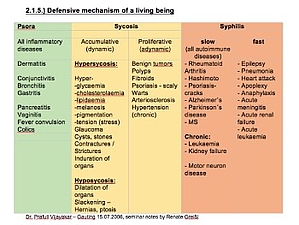2.1.2.3.) Syphilis
2.1.2.3.a.) Pathogenesis and symptoms of syphilis:
If the organism cannot cope with a pathogen, toxin or disease despite a psoric
or sycotic defensive reaction, it decides in favour of the destructive defense reaction. Here, part of the body is sacrificed, i.e. destroyed, to save the rest of the organism.
2.1.2.3.a.) Symptoms of syphilis:
· All symptoms head towards destruction
· Deformity, disfigurement, repulsive, abnormal, crooked, bent
· Violent infections, inflammations that turn into destructive pathologies and often become life-threatening
· Ulcers, gangrene, cracks, deep, bleeding, evil-smelling
· Bleeding
· Difficult for wounds and injuries to heal, or they do not heal at all, bleed easily, evil-smelling discharge
· Pain: severe, hysterical, migrating
· Hysterical complaints and hypersensitivity
· Fractures, destructive wounds
· Caries of the bones, cartilage
· Discharge: cankerous, evil-smelling, bloody
· Uncontrollable symptoms
2.1.2.3.b) Syphilis diseases:
· Septicaemia
· Cancers
· Ulcers: cancerous, ulcus cruris, ulcerative colitis, stomach ulcer, ...
· Autoimmune diseases (Hashimoto, rheumatoid arthritis)
· Myocardial infarction, cerebral haemorrhage
· Kidney failure
· Atelectasis (collapse) of the lungs, emphysema
· Interstitial fibrosis
· Caries of the bones, bone fractures
· Motor neuron diseases, Parkinson's disease, cerebral paralysis
· Schizophrenia, idiocy, obsessive compulsive disorder, anorexia nervosa,
· Cachexia
2.1.2.3.c) The syphilitic mental and emotional state:
The behaviour is characterised by destruction, disfigurement and perversion. The state is out of control.
· Aversion to everything, to oneself, to the business, to family members, to getting married
· Panic, great fear with inner restlessness
· Violence, vehemence, destructiveness, bent on destruction; fire, wants to set things or the house on fire;
· Compulsive, mentally distant, as if far away; constantly washing his hands;
· Apathy, listlessness and indifference
· Anorexia nervosa
· Answers imaginary questions; answers incoherently, irrelevantly, without relation to the question
· Cruelty, brutality, barbarity; malicious; unfeeling, hard-hearted; insensitive, lack of sensitivity;
· Kill, urge to;
· Requests, asks for nothing;
· Catalepsy (certain posture is constantly maintained)
· Exclusion of persons against their own will; mood of rejection, unwilling;
· Swearing, blasphemy, profanity; godless, lack of religious feeling
· Suicidality, desires death; thoughts of death
· Despair
· Distant, cut-off, unsociable
· Intellectual development inhibited; frozen development; retarded
· Eccentricity, extravagance; euphoria, enthusiasm; fanaticism; high spirits, exaggerated cheerfulness
· Boredom
· Alienated
· Hallucinatory fantasies, figments of the imagination, quirks, exaggerated; mania, insanity;
· Leaves his/her own children; relatives, leaves in the lurch
· Hysteria, hysterical symptoms
· Imbecility, dementia
· Psychosis, phrenesis, mania, insanity, schizophrenia
· Masochism; sadism; perversion
· Desire to be killed, to kill.
· Laments, deplores, moans
· Laughter hysterical, involuntary, immoderate, uncontrollable, serious matters;
· Indecent, obscene; shamelessness; nakedness, desire;
· Malicious, spiteful, vindictive
· Misanthropy
· Moral disorders, unsocial, antisocial, lack of morality; tendency to become a criminal
· Nymphomania;
· Fury, rage, frenzy;
· Dismissive attitude
· Tendency towards slander
· Strange, weird, eccentric.
· Sighs
· Hurriedness, haste, can't do things slowly
· Counts all the time
2.1.2.3.d)Syphilitic triggers:
· Shock, insults, humiliation, abuse
· Injuries
· Sudden rage, frenzy.
· Panic
· Strongly suppressed rage
· Sudden loss of loved ones and animals
· Sudden joy
· Sudden loss of business, money, honour
· Drugs and oppression
· Physical trauma
2.1.3.) Why is it important to recognise the miasms and to work with miasms?
· Healing chronic diseases is much easier if the miasms are recognised and treated.
· Only when you know which miasma is predominant will you know which miasma to treat.
· If the patient is in the psora, the psoric symptoms are sufficient.
· If the patient is in sycosis, we have to try to find syphilitic symptoms and connect them to the psoric
symptoms from the past, when the patient was still psoric.
· In the syphilitic miasm we deal with it in the same way. But here the syphilitic symptoms are
indispensable.
· Only if you know which miasm the patient is in can you determine whether it is a question of suppression
(into a deeper miasm) or healing (into a more superficial miasm) during the course of the treatment. The
healing process must go from a deeper miasm to one that is not as deep. If this happens the other way
around, it results in suppression.


sources:
Samuel Hahnemann, The Organon of the Healing Art, 6thedition according to the edition by Richard Haehl 1921, Haug Verlag
Dr. Prafull Vijayakar – Gauting 15.07.2006, seminar notes by Renate Greißl
picture:
public domain 30.07.2019
